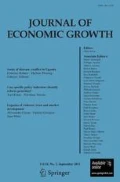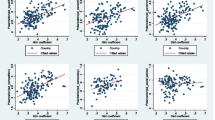Abstract
Understanding whether the gap between rich and poor country wellbeing is narrowing is really about whether rich and poor groups can be identified in the overall size distribution of the characteristic of interest, and how those respective subgroup size distributions are changing. Here two simple statistics for analyzing the issue are introduced which are capable of discerning, in many dimensions, changes in the underlying distributions which reflect combinations of increasing (decreasing) subgroup location differences and decreasing (increasing) subgroup spreads, which are the characteristics of polarization (de-polarization). When applied in an examination of the distribution of lifetime GDP per capita over time, the population weighted version exhibits de-polarization and the unweighted version exhibits polarization. As a collection of countries, Africa is diverging from the rest of the world regardless of the weighting scheme.
Similar content being viewed by others
References
Anand S., Segal P. (2008) What do we know about global income inequality?. Journal of Economic Literature 46(1): 57–94
Anderson G. (2004a) Making inferences about the welfare poverty and polarization of nations: A study of 101 countries 1970–1995. Journal of Applied Econometrics 19: 537–550
Anderson G. (2004b) Towards an empirical analysis of polarization. Journal of Econometrics 122: 1–26
Anderson G. (2005) Life expectancy, welfare and inequality: The example of Africa in the 1990s. Review of Income and Wealth 51(3): 455–468
Anderson, G., Crawford, I., & Leicester, A. (2010). Welfare rankings from multivariate data, a nonparametric approach. Journal of Public Economics, 95(3–4), 247–252. doi:10.1016/j.jpubeco.2010.08.003.
Anderson, G., Linton, O., & Whang, Y.-J. (2009). Nonparametric estimation of a polarization measure. Department of Economics, University of Toronto, Mimeo.
Barro R. J., Sala-i-Martin X. (1992) Convergence. Journal of Political Economy 100(2): 223–251
Beaudry P., Collard F., Green D. A. (2005) Changes in the world distribution of output per capita 1960–1998: How a standard decomposition tells an unorthodox story. Review of Economics and Statistics 87(4): 741–753
Becker G. S., Philipson T. J., Soares R. R. (2005) The quantity and quality of life and the evolution of world inequality. American Economic Review 95(1): 277–291
Bianchi M. (1997) Testing for convergence: Evidence from non-parametric multimodality tests. Journal of Applied Econometrics 12(4): 393–409
Bourguignon F., Morrisson C. (2002) Inequality among world citizens: 1820–1992. American Economic Review 92(4): 727–744
Browning M., Lusardi A. (1996) Household saving: Micro theories and micro facts. Journal of Economic Literature 34(4): 1797–1855
Decancq K., Decoster A., Schokkaert E. (2009) The evolution of world inequality in well-being. World Development 37(1): 11–25
Duclos J.-Y., Esteban J.-M., Ray D. (2004) Polarization: Concepts, measurement, estimation. Econometrica 72: 1737–1772
Durlauf, S. N., & Fafchamps, M. (2005). Social capital. In P. Aghion & S. Durlauf (Eds.), Handbook of economic growth (Vol. 1), Chap. 26. Amsterdam: Elsevier.
Durlauf, S. N., & Quah, D. T. (1999). The new empirics of economic growth. In J. B. Taylor & M. Woodford (Eds.), Handbook of macroeconomics (Vol. 1), Chap. 4. Amsterdam: Elsevier.
Durlauf, S. N., Johnson, P. A., & Temple, J. R. (2009). The econometrics of convergence. In T. C. Mills & K. Patterson (Eds.), Palgrave handbook of econometrics, Vol. 2 of Applied econometrics New York: Palgrave Macmillan.
Eddy W. F. (1980) Optimum kernel estimators of the mode. The Annals of Statistics 8(4): 870–882
Esteban J.-M., Ray D. (1994) On the measurement of polarization. Econometrica 62(4): 819–851
Fleurbaey M. (2009) Beyond GDP: The quest for a measure of social welfare. Journal of Economic Literature 47(4): 1029–1075
Fleurbaey M., Gaulier G. (2009) International comparisons of living standards by equivalent incomes. Scandinavian Journal of Economics 111(3): 597–624
Foster, J. E., & Wolfson, M. C. (1992). Polarization and the decline of the middle class: Canada and the U.S. Nashville, TN: Vanderbilt University, Mimeo.
Friedman M. (1957) A theory of the consumption function. Princeton University Press, Princeton, NJ
Galor O. (1996) Convergence? Inferences from theoretical models. The Economic Journal 106(437): 1056–1069
Hartigan J. A., Hartigan P. M. (1985) The dip test of unimodality. Annals of Statistics 13: 70–84
Henderson D. J., Parmeter C. F., Russell R. (2008) Modes, weighted modes, and calibrated modes: Evidence of clustering using modality tests. Journal of Applied Econometrics 23(5): 607–638
Islam N. (2003) What have we learnt from the convergence debate?. Journal of Economic Surveys 17(3): 309–362
Johnson P. A. (2000) A non-parametric analysis of income convergence across the US states. Economics Letters 69(2): 219–223
Johnson, N. L., Kotz, S., & Balakrishnan, N. (1994). Continuous univariate distributions, Vol. 1 of Wiley series in probability and mathematical statistics. Hoboken, NJ: Wiley-Interscience.
Jones C. I. (1997) On the evolution of the world income distribution. The Journal of Economic Perspectives 11(3): 19–36
Jones, C. I., & Klenow, P. J. (2010). Beyond GDP? Welfare across countries and time. NBER Unpublished Working Paper No. 16352.
Mankiw G., Romer D., Weil D. N. (1992) A contribution to the empirics of economic growth. Quarterly Journal of Economics 107(2): 407–437
Mann H., Wald A. (1943) On stochastic limit and order relationships. The Annals of Mathematical Statistics 14(3): 217–226
Milanovic B. (2005) Worlds apart: Measuring international and global inequality. Princeton University Press, Princeton, NJ
Modigliani F., Brumberg R. (1954) Utility analysis and the consumption function: An interpretation of cross-section data. In: Kurihara K. K. (eds) Post-Keynesian economics. Rutgers University Press, Piscataway, NJ
Nordhaus, W. D. (2002). The health of nations: The contribution of improved health to living standards. NBER Unpublished Working Paper No. 8818.
Paap R., van Dijk H. K. (1998) Distribution and mobility of wealth of nations. European Economic Review 42(7): 135–165
Pagan A., Ullah A. (1999) Nonparametric econometrics. Cambridge University Press, Cambridge, MA
Pittau M. G., Zelli R. (2006) Empirical evidence of income dynamics across EU regions. Journal of Applied Econometrics 21(5): 605–628
Quah D. T. (1997) Empirics for growth and distribution: Stratification, polarization, and convergence clubs. Journal of Economic Growth 2(1): 27–59
Sala-i-Martin X. (2006) The world distribution of income: Falling poverty and . . . convergence, period. Quarterly Journal of Economics 121(2): 351–397
Silverman B. W. (1986) Density estimation for statistics and data analysis. Chapman and Hall, New York, NY
Temple J. (1999) The new growth evidence. Journal of Economic Literature 37(1): 112–156
Wolfson M. C. (1994) When inequalities diverge. American Economic Review Papers and Proceedings 84(2): 353–358
Author information
Authors and Affiliations
Corresponding author
Rights and permissions
About this article
Cite this article
Anderson, G., Linton, O. & Leo, T.W. A polarization-cohesion perspective on cross-country convergence. J Econ Growth 17, 49–69 (2012). https://doi.org/10.1007/s10887-011-9072-3
Published:
Issue Date:
DOI: https://doi.org/10.1007/s10887-011-9072-3




